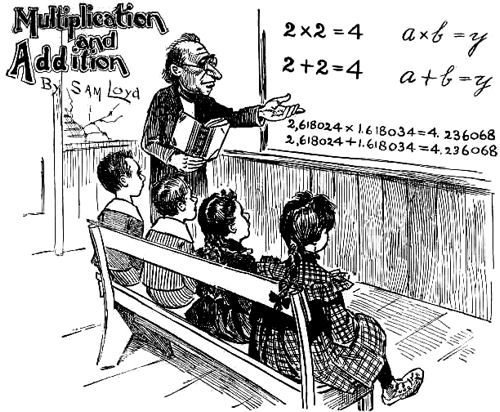



OF COURSE YOU ALL understand multiplication and simple addition and do not require pencil and paper to do a little sum like two and two make four, and yet there are peculiarities about the number 2 which many have overlooked.
Well, some time ago the editor of “Notes and Queries,” who devoted considerable space to the discussion of mathematical questions, gave a very startling reply to a searcher after information, who pointed out the fact of 2 multiplied by 2 producing the same result as 2 added to 2, and asked if there were any other two quantities which when multiplied or added together would give the same result. The editor said that there was one other solution to the proposition where a + b = y, and where a x b = y, but by a curious blunder in multiplication said 2.618024 x 1.618054 = 4.236068, just as 2.618024 + 1.618034 = 4.236068.
It is self evident that one of the quantities which we will term a or b is wrong, and as it is merely a problem in simple addition and multiplication, but is sufficiently out of the ordinary to be confusing, it is presented as a puzzle to correct one of the quantities so that the sum will be equal to the product.
It is really a curious and remarkable fact that there should be any two numbers or series of numbers which when multiplied or added together should give the same result. Calling a 2 and b 2 and y 4, we have shown as an elementary lesson in algebra that a x b = y. just as a + b = y, and it is safe to say that it would puzzle many a clever person to think of any other numbers or quantities wherewith to perform the same feat and yet there is such an endless variety that you may select any number or series of numbers by-chance and it will at once tell what to add or multiply with to produce similar results.
The rule is extremely simple and well worth knowing, as it proves that 2 is not a freak number as is generally supposed
Regarding that little puzzle in multiplication and addition, wherein it was required to show that other numbers besides 2 and 2 would produce the same results when added or multiplied together, I find that despite its extreme simplicity ninety-nine out of every hundred persons have always been led to agree with the editor of “Notes and Queries” in believing that 2 x 2 = 4 and 2 + 2 = 4 was an arithmetical feat in numbers which could not be duplicated with or without the use of fractions.
There are billions of simple answers obtained from the formula a = b/(b - 1), by giving any required value to a [for an arbitrary b, for example if b= 1 1/2, a = 3, i. e.] 3 + 1 1/2 = 4, or 3 x 1 1/2 = 4.
2. Domestic Complications.
Here is a pretty little tangle from the ordinary affairs of life, which the good housewife solved in a minute, but which drove a mathematician to the verge of insanity.
Smith, Jones and Brown were great friends. After Brown's wife died, his niece kept house for him. Smith was also a widower, and lived with his daughter. When Jones got married, he and his wife suggested that they all live together. Each one of the party (male and female) was to contribute $25.00 on the first of the month for household expenses, and what remained at the end of the month was to be equally divided. The first month’s expenses were $92.00. When the remainder was distributed each received an even number of dollars without fractions. How much money did each receive, and why?
In that matter of domestic complications, Mrs. Jones was the daughter of Smith and the niece of Brown, so there were but four persons. $100 was contributed, $92 spent and each received $2 in the distribution.
[Page 78]